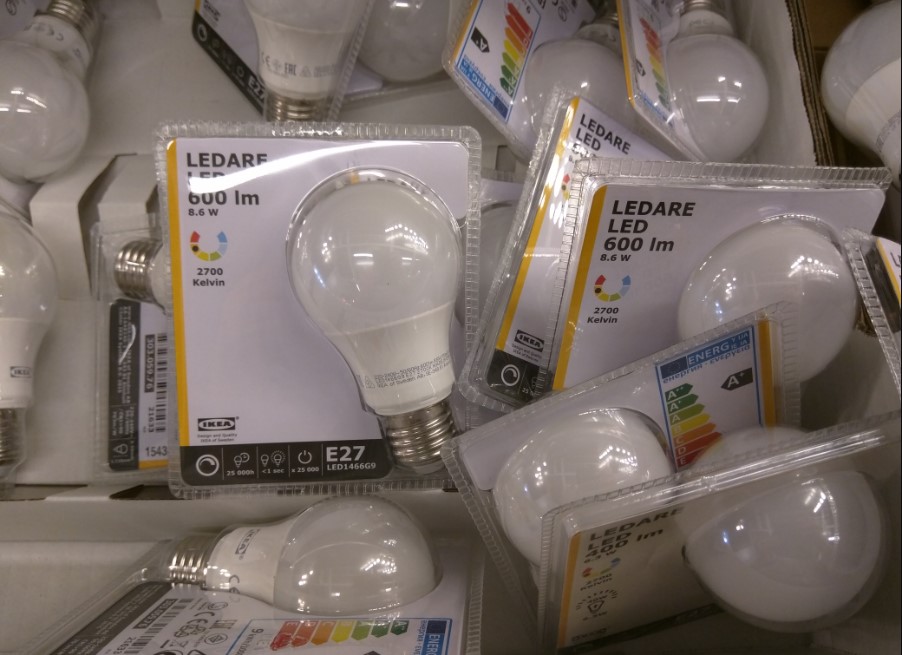Incandescent light bulbs are officially banned in the U.S.::America’s ban on incandescent light bulbs, 16 years in the making, is finally a reality. Well, mostly.
Nobody’s talking about the real casualty of this shift. What’s going to happen to all the jokes about “how many (insert category of person here) does it take to change a light bulb?” now that people don’t have to regularly change light bulbs anymore?
deleted by creator
There’s a tradeoff with CFL bulbs between longevity and instant action. The normal expectation for a light bulb is to have it at full brightness the moment you flip the switch, but the first CFL bulbs to market often took minutes to reach peak output. Longer if they were cold.
So to meet consumer expectations, manufacturers began designing bulbs that would, on ignition, damage themselves in order to reach peak output faster.
It’s no wonder the CFL bulb failed as a product, you would either get a bulb that would never be bright enough when you needed it, or you got a bulb that would burn itself out just as quickly as any incandescent for twice the price.
deleted by creator
In 2008(ish) we rewired our house (built in the '20s) and replaced every fixture. We probably had 25 CFL bulbs (most in ceiling fans), and had no losses for the several years that we owned the house after that. But I remember paying way more for bulbs in years before that and having them all fail fairly quickly.
As someone living in the EU where incandescent bulbs have been banned for over a decade, I can assure you that changing lightbulbs is still a thing. Not as frequently, but it happens, especially if you buy cheaper brands LED bulbs. They definitely does not have the longevity that they advertise.
Or the old riddle of having to match 3 lights to 3 switches with only one guess, since the solution relied on the bulb getting hot and LEDs barely get warm.
No single LED lightbulb I’ve ever purchased lasts as long as they claim. infact, many have been outlasted by existing incandescent bulbs in my house. your joke fodder is safe.
I don’t know what kind of shit LEDs you’ve been buying but I’ve yet to ever have to replace one. Been using them for many years already.
The U.S. is pretty late with this, compared to the European Union. Only a few special bulbs are still sold here. Apart from that, the only allowed lighting technology is LED.
Tell that to the bar I was at last night in Palermo. They had a string of festoon lights going down the laneway and every one of them was incandescent. I noticed the same in Taormina. In fact, Italy seems pretty far behind the rest of the EU when it comes to environmental concerns…but that’s for another thread.
Are you sure they were incandescent bulbs and not just LED bulbs copying the incandescent style? They make a lot of decorative LED bulbs now with straight sections of LEDs to imitate the glowing wire of an incandescent.
Are you talking about an Edison bulb?
Having grown up in the era of incandescent bulbs I remember the fancy white bulbs made with frosted glass being more expensive than the totally transparent ones you could see the glowing filament inside, because the filament was irritating to look at and the frosted ones smoothed out the light for you.
I’m very amused that we’re now jumping through hoops to make skinny LEDs that can fake the look of the old filaments nobody wanted to look at back then, and those are now the fancy expensive ones.
This is one example of the LED bulbs I was describing, but there’s plenty of different styles of these being made
Definitely. I’m an electrician, so my eyes are usually drawn to these type of things. Light fittings, outlets, switches, etc.
They are not sold anymore, but whatever is left and working can still be used. Many people also bought a ton of incandescents before the selling stopped (tHe lIgHt is sO mUcH bEtTeR!!!)
tHe lIgHt is sO mUcH bEtTeR!!!)
narrator voice: “but it was not”
It can be. Cheap LED lights with low quality AC rectifiers are awful. If those are your point of comparison then yes, incandescent light is better (more steady).
Of course that difference goes away if you just get a better LED light.
Some also have terrible CRI. Nothing like giving everything a subtle green or purple tint.
yeah, i was referring to current tech. First LED or those mercury vapor bulbs were basically useless.
You can definitely get “current” LED bulbs with bad hardware inside still today. See: Everything made by NOMA.
You could also get ultra cheap crappy incendescant bulbs in the past.
It generally is though. The look of incandescent and halogen is only rivaled by high end LEDs.
nah. in my experience, even cheaper LED bulbs from discounters can nicely replace old bulbs.
It’s true that what “el-cheapo product” once was done by simply reducing lifetime is currently done with looks.
Maybe they still run on “new old stock” bulbs until they are used up. But even if they do, they clearly didn’t do the math. I’ve upgraded all my lighting to LED and binned all my incandescent stock.
I’m sitting inside a house where, presently, all lights turned on at the same time will require 30w. Before we went through all the lights, a single lightbulb would use 45w.
Just by replacing the old light bulbs, we reduced energy consumption and the number of lights required to light a room.
I think to update the string of lights you’d need to change transformer. Household bulbs have a driver in the bulb that converts the 230V to the ~12V the bulb uses. But for that string of lights, they’d need to get an electrician (or someone who knows what they’re doing)
While you may need to replace the whole strand, and can’t just swap in individual bulbs, the strand itself has the resistors needed to let the LEDs function, instead of the individual bulbs.
This applies to all the things, unfortunately. It must be nice to have a functional union. Even though I’m sure it’s not perfect, progress is made at a decent pace. Our country is hijacked by a cruel/angry/illiterate cult every 1-2 elections, it’s not ideal.
Wondering if incandescents can still be sold as heat bulbs because that’s what they are
Yes they can. Also your fridge and oven will still have incandescent bulbs because more efficient lights aren’t great at operating in extreme temperatures.
manufacturers can still build and stores can continue selling:
Appliance lamps, including fridge and oven lights Black lights Bug lamps Colored lamps Infrared lamps Left-handed thread lamps Plant lights Floodlights Reflector lamps Showcase lamps Traffic signals Some other specialty lights, including marine lamps and some odd-sized bulbsWe have an LED light bar in our deep freezer and also our mini fridge. LEDs seem to work absolutely fine in the cold actually.
Yeah, LEDs are pretty ideal in the cold as long as they’re properly sealed from humidity. They don’t heat up your fridge extra every time you open the door. Oven lights definitely wouldn’t work unless you want a nice plastic glaze on top of the cake you’re baking.
You are correct about everything but I feel I should point out that the amount of heat produced by an incandescent bulb in your fridge is miniscule compared to the heat energy of the warm air that enters your fridge as soon as you open the door. Cold air sinks due to its density and so when you open the door it all falls out and your fridge must work it’s ass off to cool all the new air back down to the set temperature. The heat added by an incandescent bulb for a few seconds is basically irrelevant.
This is also why chest freezers are so tremendously efficient. When you open the lid, the cold air stays inside. Very little mixing occurs with the rest of the environment.
Yeah, it’s not a lot of heat, but it starts making a bigger difference once you’ve got the fridge packed full of stuff (less air loss, also makes it take longer to find stuff, so the light stays on longer). I’ve had items at the back near the bulb get extra freezer burned because of the constant heating/cooling. That was quite an old fridge/freezer though, so not the most efficient to start with, and the temperature control could have been better.
I do love chest freezers. They’re way more efficient and I find a lot easier to organize too. There’s some fridge/freezer combos that have a freezer drawer, but I’ve yet to find one that’s fully enclosed so all the cold air stays in. Most I’ve seen have wire baskets or something for the drawer… Having space for a separate chest freezer is not a luxury everyone has.
We call them “space heaters”…
What is not banned?
Surprisingly, there is a whole slew of exempt special-purpose bulbs that will continue to be manufactured, according to the Energy Department. Here’s what manufacturers can still build and stores can continue selling:
- Appliance lamps, including fridge and oven lights
- Black lights
- Bug lamps
- Colored lamps
- Infrared lamps
- Left-handed thread lamps
- Plant lights
- Floodlights
- Reflector lamps
- Showcase lamps
- Traffic signals
- Some other specialty lights, including marine lamps and some odd-sized bulbs
I mean, good for the effort, but that’s still a lot of exceptions.
If you still have a fridge or oven that takes incandescent bulbs, isn’t it better to replace the bulb than the fridge? If the point is minimal environmental impact then I think that makes sense.
That’s true, but that’s also still a lot of incandescent light bulbs. I guess you have to compromise somewhere, for now at least.
Well sure but you could just replace it with an LED bulb…
Edit: missed the word oven. My question is just for fridges
I don’t think you can put an LED bulb in an oven, well I mean I guess you could try but good luck with that, I don’t imagine it would last very long at all.
You can put an LED bulb in a fridge though, I put LEDs in mine. I don’t really need to worry that much about my oven though because it’s a small oven and doesn’t have a light in there to begin with.
I mean why would you force LEDs for ovens in the first place. The place they are in is supposed to get hot. And that’s what the ineffeciency in incandescent light bulbs normally is. They get hot. Doesn’t seam like an issue that they make the place that’s supposed to get hot hot.
The enefficiency is that they take up nearly a magnitude more power and last a fraction of the time, meaning you have to manufacture 20x more of them.
Having said that, I’m not sure if I support this change. People are already switching light bulbs naturally. It saves energy, doesn’t heat up, and lasts longer. You don’t really need much more incentive than that. I wonder if this will have any meaningful impact whatsoever. And if it doesn’t, why are we banning items for no societal benefit?
Apparently they do have a long list of exemptions, at least. I think legislative focus would be better spent on increasing renewable energy production. Solar, hydro, wind, nuclear.
I hate to break it to you, but the heating element in the oven uses a magnitude more energy than that little old incandescent light. And the energy otherwise lost from an incandescent light is lost to heat, which just so happens to be the entire purpose of an oven. So in the case of an oven, there’s actually no more energy lost than the heat it’s already designed to generate.
Besides, have you ever tried putting electronics in an oven? LED’s don’t exactly like heat ya know…
I don’t know about the energy efficiency, but the life time of the bulb is a variable that they intentionally designed that way. They know how to make an incandescent light bulb that will last indefinitely. The industry colluded with each other to manufacture bulbs that have to be replaced frequently.
…Why not both? It makes sense for it to be illegal to sell a device that consumes more than 6x the power of the equivalent and dies significantly more frequently. I searched for statistics and it seems like 20-30% of bulbs sold are incandescent. That means well over half the energy consumption of light bulbs still comes from them. It’s low hanging fruit that can have an almost immediate impact, even if it’s not enough on its own.
Those 20~30% are likely either a) appliances like people are mentioning. Stoves, fridges, etc. Which have reasons for being incandescent for which the law gives exemptions and b) old bulbs that would have inevitably been changed to incandescent anyway
I really think this law isn’t going to make a significant difference in the % of incandescent bulbs over the next few decades. We’re essentially going to transition at the same rate to a fully LED, whether the law existed or not.
So my question is - what’s the point? We waste political capital and time that could be better spent doing meaningful things. And we can do things that don’t arbitrarily restrict the choices of our citizens.
It’s paying lip service without actually doing anything. Theatre.
Make our energy production 100% renewable and it doesn’t matter in terms of carbon emissions if your bulb uses 4x more energy (of course ignoring production emissions, but just for the sake of rhetoric)
This article is dogshit, and those are not the current exemptions. DOE revised the definition of a general service lamp on 2022 to include the majority of reflectors. The rest have miniscule sales and have technical limitations that make LED replacements difficult. It’s not a lot of exemptions. When was the last time you bought a left hand thread or a colored incandescent lamp?
deleted by creator
Seems like it’s a theft deterrent since they won’t work in “normal” sockets?
You need a history expert for this one. I want to say theft deterrent, and possibly different voltages for niche applications. Also Need Flanders Leftorium.
I don’t get the exception for colored incandescent. LEDs come in whatever color you want, or get a smart bulb to change it at will
Some of these bulbs might be difficult to find in LED and there might be other considerations like shape, heat, dimmer compatibility, etc… Replacing fixtures could represent a significant burden in these cases and thought there are many exceptions listed they likely represent a small percentage of overall usage.
I’ve seen dimmer compatible LEDs and, even better, LED bulbs that have built in control of light intensity and even color. I’ve even seen bulbs capable of playing music through bluetooth!
Shape I don’t really see as a concern, as any shape an incandescent bulb can be produced in, a LED bulb can also be. And then some, as the LEDs can be set up, twisted and bent into some very imaginative shapes and angles.
And heat is not ready a concern. You can touch most LED bulbs with your bare hands with no risk of severe burn. Unless very high wattage is in play, at most, a LED bulb will be warm to the touch.
Try not to dismiss everything so quickly. I came up with those in 5 minutes but a committee of experts could find many more. When the exceptions were written they had a reason. A few examples:
-
In a traffic fixture, the heat that the incandescent bulb generates often serves to melt ice, and early traffic fixtures with LEDs did have icing problems. Replacing the fixtures would represent a significant burden.
-
An LED wouldn’t survive in an oven and oven lights aren’t on for very long either so what would it matter?
-
A bulb in a refrigerator could be exposed to condensation.
-
Dimmer compatible LEDs require pulse width modulated dimmers. Incandescent dimmers are often resistance dimmers.
The exception are there to make sure that a $1 part doesn’t render a $1000 appliance inoperable. Replacing the appliance would undoubtedly generate a ton more carbon than using an incandescent and the rule doesn’t say that LED bulbs are prohibited just that incandescent bulbs for those uses are not yet banned.
I’ll also point out that LEDs are made of plastic and essentially become ewaste at the end of their life so there is a trade off to consider too.
LED refrigerator bulbs are already a thing; bought one recently by accident, when looking for a very low power/low brightness for a bed side table.
Those, apparently, are no longer a concern.
Screw in LED bulbs with built in brightness and color control, that you can command from a phone application or through a conventional remote control, are already common, thus rendering conventional dimmers obsolete.
Why keep those? To my very limited knowledge, dimmers can require expensive and extensive installation.
I have seen LED traffic lights with built in anti frost measures and the expenditure to have those replaced is not a good argument to keep that particular use of incandescent lamps around.
LED low power requirements, paired with their long service life, enables traffic lights to be independent from the power grid, through the use of solar panels and batteries, keeping it working even when severe weather disrupts energy distribution. LEDs are also brighter and easier to see from afar.
There may be very particular cases where incandescent bulbs still do not have an alternative but to say they are irreplaceable is a disservice.
I’m not trying to be dismissive, I’m trying to be demanding.
I have a garage door opener and I guess it’s just not shielded well enough because LED light bulbs interfere with the signal from my remote, just one example. I would much rather buy new incandescent bulbs every few years than replace the opener outright.
-
And heat is not ready a concern. You can touch most LED bulbs with your bare hands with no risk of severe burn.
This very clearly indicates that you haven’t seriously considered this issue at all, and are just supporting your political faction with no reflection on what the unintended consequences might be.
A common application of incandescent bulbs is to produce heat, for a variety of use cases. The typical example is an improvised chicken incubator.
Consider very carefully why there’s an exception for traffic signals.
This is exactly what I was getting at. There are so many considerations and they clearly put some thought into the exception list even though the reasons may not be readily apparent. The order is not a small step in the right direction it’s a significant step in the right direction and the impact on actual electricity usage is going to be massive.
the impact on actual electricity usage is going to be massive.
Is it?
How many people are still installing new incandescent bulbs in 2023?
Is there an actual study showing the expected costs and benefits of this rule, or is it purely political posturing?
The article had an estimate from the DoE. Idk, be mad about it if you want. LED bulbs aren’t perfect but what is.
“As the rules reinforce existing market changes, the Energy Department believes that U.S. consumers can save almost $3 billion annually on their utility bills. Similarly, it projects that the rules could cut carbon emissions by 222 million metric tons over the next 30 years.”
I can’t find such a study, and it seems extremely unlikely to me that any such study was performed recently. The original law was passed in 2007, and then the regulations were in political limbo for more than a decade.
My base hypotheses here, subject to easy refutation by any real evidence, are that:
- The DOE has looked at no study from after 2007 to justify their current policies.
- This regulation is going into effect now simply because it was on the list of stuff Trump did that the Biden admin reversed.
- The effect on consumer electricity costs and carbon emissions are negligible, since LED bulbs are a decade cheaper and better and almost everyone voluntarily buys them.
Black lights
Nice.
They’re lights that emit in the ultraviolet part of the spectrum for the purpose of making fluorescent materials light up. To the human eye they don’t look quite black, but more like a darkish purple.
But yeah, I too always found the name deliciously ironic.
deleted by creator
can we ban standard time and permanently switch to DST now too?
i thought we did?
oh fuck me we didn’t
Senate passed the bill by unanimous consent, although several senators stated later that they would have objected if they had known that the bill could pass. No iteration of the bill has passed the House.
WTF? Why the heck would those people have wanted it to fail and why would they vote for it if they did?
And since it got unanimous consent in the Senate, why the heck didn’t it go to the house? It’s the rare case of a bill that I think everyone likes.
To appease voters
Tell me your government is fundamentally broken without telling me…
Ha, do you live in Arizona?
DST is the best thing ever. Who doesn’t want more daylight after work?
Oh yay it’s bright at 4am in the morning when I’m asleep.
What about 4am in the evening?
Just pick a time and stick with it
I’ve been in the industry for over a decade and I find it fascinating how much lighting has changed in that time. When LEDs were first available, they were $60+ per bulb. Now you can get multipacks for under $10. Also, CFL bulbs were almost universally hated by everyone (and for good reason) now we no longer sell them. We strictly sell LEDs for regular lighting and we still sell incandescent specialty bulbs. Also, when LEDs first arrived there was a lot of distain for them, especially by the elderly. They wanted their energy wasting incandescent bulbs dammit! It seems the majority of them have come around because they’ve learned that LEDs are better.
I think the main issue with initial Led bulbs was their color was wrong. Incandescent bulbs emit light at 2700K, a nice warm white. Early LEDs emitted light at more like 5000K or there abouts, which is a really white light. Same with CFLs. Elderly people didn’t like that at all. Honestly it wasn’t just them, lots of people hated them for their too white of light.
Today you can get LEDs that are 2700K and/or are adjustable to what ever color you want.
Any recommendations? I’ve struggle with LED light color temp off and on over the years. I haven’t looked into it in a while though. It always seems like if you want a low color temp it has to be an edison bulb which is really dim.
On a separate note I’ve also had reliability issues with LED bulbs where they will blow out and emit smoke.
Look for colour names like “soft white” or “warm”. The 2700K is a dead give away for the colour you’re looking for.
Also, separate note: check your appliances or fixtures for power spikes. cheaper LEDs are notoriously sensitive to voltage fluctuations
how would you check for that exactly?
Look closely at packaging. If you’re in North America, Phillips is the most common for bulbs. They have packages marked 2700K, 5000K, and 6500K.
The colours are as follows: 2700- soft white (yellow hue), 5000- bright white (white hue, almost no colour), and 6500- day light (blue-ish hue, similar to fluorescent).
If you end up not being able to distinguish… ask an employee and they should be able to help
i meant checking for power spikes lol
Lol im dumb… forgot it was a 2 pt question.
Cheap way is to buy a surge protector/ power strip with surge protector.
Plug in appliances/lights that burn out faster than others. Periodically check surge protector to see if the internal breaker has been tripped.
Fancy way is to buy a multimeter and monitor voltage when large appliances turn on/off. That’s usually the most likely culprit for voltage spikes (as your home grid has to compensate for sudden increase in usage, which in turn causes voltage to fluctuate slightly)
It seems the majority of them have come around because they’ve
learned that LEDs are better.died
they died
I’m sure some of them have
The most amazing thing to me - I’ve been using leds for 10+ years, and I think I’ve had to replace one or two of them. It is a wonder that prices can come down with demand dwindling so much.
Man, I remember as a kid we had a box of bulbs for when inevitably one burnt out each month or so. Now, I have a drawer with a bunch of led bulbs I’ll never use because they don’t burn out!
I remember when I was a kid, it seemed like we had to change the light bulbs every other month. Now I’m annoyed because these things last so long I don’t keep any spares and I have to leave my house to buy one when it expires!
I can’t remember ever having to replace a dead LED bulb. And only a few CFLs. But I remember replacing incandescents all the time when I was a kid.
I had to replace an LED bulb a few months ago and I remember being annoyed because they did only lasted five years.
Also it became a political issue as all things should be somehow
Yes. Many of the people that objected also wore MAGA hats. I think the whole idea was that it was better for the environment and you know what that means.
I specifically remember trump saying something about bringing back yellow light 😮💨
Is there a brand that’s better for LED? I get migraines and the stroking effect of LED bulbs can be a trigger.
LED christmas bulbs particularly bad. It felt like walking into a rave at the Christmas store.
Regular brand LED bulbs don’t strobe at all, only the very cheap ones from AliExpress and the resellers of Chinese crapware (like Walmart) do. IKEA has some nice and cheap bulbs, for example.
Yeah, many of those christmas lights use pulse width modulation to control brightness and it is very noticeable. I hope that gets changed over for an analog voltage dimmer soon.
There are LEDs with CCD power converter. I got one 10 years ago and tested it with a 240 fps camera, no flicker at all. I will not recommend a brand because it’s been years,but search for “ccd led bulb”.
Also there’s a number called CRI, indicating how well it represents colors. This also may contribute to your headaches. 85 or higher is good, 90 is great. Just don’t trust these numbers on Amazon, the cheapest of cheap crap is marketed as " cri 90+" there.
Or scratch what I just said and find a small store that specializes in lighting and ask the clerk (or email them).
That, but also change happens one funeral at a time.
deleted by creator
The 3 biggest issues CFLs had were their warm up time, especially in cold weather, the flicker some people are sensitive too, and they contain murcury as all florescent bulbs do. That means it is absolutely necessary to properly dispose of them so mercury doesn’t get into the ground water.
This is why I don’t support overreach in regulation.
Put a tax on it or something, but a full ban seems excessive. Now that most people understand that LEDs are superior, they are cheaper, and there are more options, most people will make the switch.
No really. A lot of people, even when shown proof, out of simple spite just double down on their position.
When energy saving and early LED bulbs started to be deployed in my country, while the fade out of incandescent bulbs was put in place, we had runs for buying every single incandescent bulb available. The change was not welcome. Even if changing meant real, objective, tangible savings.
People would put in large orders for bulbs, arguing they wanted to “have proper lighting as long has they lived”. Luckily, the stocks quickly ran out and some distributors simply refused to pass the stocks to the market.
A government cutting off a product is not overreach: it’s forcing change that otherwise would not happen, for the better.
A lot of people, even when shown proof, out of simple spite just double down on their position.
But is it enough to really matter? Especially after the market for incandescent shrivels?
I’m sorry, I’m not following your reasoning. Can you elaborate, please?
People will bitch about the one guy buying all the incandescent bulbs but ignore the fact that everyone else isn’t.
1 old dude isn’t enough to make a difference.
This wasn’t one or two isolated cases: it was a race to the stores.
I was a kid then and my grandparents got caught in the wave and bought more lamps that they required to light the entire house. Which later proved to be of bad quality and aided me in making their transition to energy saving bulbs.
People would line up in front of stores to get the precious, precious bulbs, making the exact same sort of conversation and observations we can read throughout this thread, criticizing government and politics in general.
The store owners would chime in and add fuel to the fire, stating a lot of people would lose their jobs, as the factories would close (cute fact: there was precisely zero factories for those products in the entire country).
People are stubborn and will not change ways unless no other option is available and even then grudgingly, while companies only shift practices if forced, be it by force of law or by cash flow and profit goals.
Governments enforcing positive laws and regulations, even if unpopular, are necessary measures to move things forward in a modern society.
Most people willingly migrated to LEDs when the circumstances shifted in their favor. There was absolutely no law required. The fact that most people are using LEDs before this was even enforced kinda proves my point. The number of holdouts is small enough to be ignored.
No really. A lot of people, even when shown proof, out of simple spite just double down on their position.
When energy saving and early LED bulbs started to be deployed in my country, while the fade out of incandescent bulbs was put in place, we had runs for buying every single incandescent bulb available. The change was not welcome. Even if changing meant real, objective, tangible savings.
People would put in large orders for bulbs, arguing they wanted to “have proper lighting as long has they lived”. Luckily, the stocks quickly ran out and some distributors simply refused to pass the stocks to the market.
A government cutting off a product is not overreach: it’s forcing change that otherwise would not happen, for the better.
Wrap it up boys, we’ve solved climate change.
Is your point we should not be taking steps to decrease electricity usage because this step by itself doesn’t fix the entire problem?
People will complain about climate change than complain about LITERALLY EVERY SINGLE ATTEMPT to improve it. Isnt this what people are always saying needs to happen?? That individual action isnt the way but we need legislature to fix everything? What did people think would happen if governments try to fight climate change? That our lives would in no way shape or form be affected?
The answer is everyone else has to fix climate change. Everyone but me
When you have billionares shooting off joy ride rocket ships to space putting out more pollutants than 1000 regular people do in a lifetime per trip, yeah, my recycling everything and switching to oat milk is a pretty futile effort. Individual actions are fine, but there are some things that need the force of law to make a difference.
Agreed, both are completely required.
You’re only one person, you don’t have to take full responsibility for all of climate change. But you can take responsibility for your slice of climate change
This line of discussion needs hard numbers.
https://ideas.ted.com/environmental-impact-carbon-emissions-of-space-tourism/
https://gizmodo.com/jeff-bezos-space-joyride-emitted-a-lifetime-s-worth-of-1848196182
Like many things there is a lot of back and forth depending on what numbers you throw into the calculation. Raw carbon from the rocket fuel may be low, but taking in indirect sources raises the totals dramatically. I prefer to look ilat the totality of things since things like flying private jets to the launch site wouldn’t happen if there where no launch to attend.
Well, sure, space tourism emissions are gonna be relatively enormous compared to other forms of travel, but I was thinking of stuff like that, versus typical individual emissions, emissions by industry, etc., as % of total global emissions.
75 to 1000 tons of CO2?
That’s, what, 5-62 years of an average American lifestyle?
Honestly, that’s not so bad lol
It’s just a joke, we need to do much more
The EU introduced a limitation to how much power electric devices can consume in off or standby mode.
0.5 watt normally, 1 watt if they have a status display and 2-8 watts if they’re connected to a network.
On a yearly basis this saves as much electricity as one of the member states (Romania) used in a year.
My point is that small things add up to huge numbers.
LED bulbs aren’t really even a small thing.
going from a 100W bulb to a 15W bulb, or a 60W bulb to a 2.5W bulb (that’s the actual conversion for the bulbs i’ve actually bought on amazon and am currently using, not hypothetical guesses) across 20-30 bulbs in a single house is a real actual big difference in energy savings.
Exactly. From this particular article/policy:
Similarly, it projects that the rules could cut carbon emissions by 222 million metric tons over the next 30 years.
Now instead of throwing out a little glass and wire, I get to throw out entire light fixtures with non-replacable LEDs soldered onto cheap PCBs that fail in about the same time as an incandescent light bulb!
I’m all for the energy efficiency of LEDs, but the cheap light fixtures replacing bulbs are a bad trend that needs to die, but they’re easier to wire and last longer on paper, so they’re getting installed everywhere by default.
So don’t buy non-replaceable fixtures?
How is removing incandescent bulbs from the marketplace going to increase the installation of fixtures with non-replaceable components, when such fixtures never used incandescent bulbs in the first place?
It can be difficult. I started asking around about getting recessed lighting installed in my kitchen and they all wanted to install disk lights.
These seem even worse since not only do you have to replace the fixture when it burns out, but you risk having to replace all the fixtures when it varies by color temperature or trim
They should charge you less for using cheaper material, reduce labor costs etc and charge the regular rate (like they fucking die before) to install a recessed fixture.
Overall, capitalism and rampant, irresponsible consumerism is to blame for all these quick fix solutions and lack of repairable devices. There is not one person to blame but ourselves for continuing to buy into this bs (literally)
For what it’s worth I’ve had one of those integrated overhead fixtures in my kitchen for about 6 years. It hasn’t failed yet. The overall shape of the fixture which we like also wouldn’t be possible if the bulbs were replaceable.
The light fixture in my apartment started flickering and not turning on all the way, and it was only a few years old (On a dimmer switch, the dimmer-compatible driver in the fixture died). I couldn’t even fix it myself because it’s hardwired and my landlord wouldn’t be happy with me playing electrician. So I was stuck with no light in that room for weeks until the landlord got it replaced.
Not to mention I couldn’t change the color temperature to match the rest of my lights, which drove me nuts.
OK, and? LEDs typically last way longer than 6 years, but it’s still going to be a pain to replace when it does fail.
They’re not all bad, there are many bad ones though and the light bulb form factor is better for repairability (but there are bad LED bulbs too).
Your sample size of one is useless
Well actually I’ve got one in my laundry room too and that one hasn’t failed either so it’s really a sample size of two. But either way if you don’t like it that’s why I said for what it’s worth.
Still useless
This has everything to do with implementation and complications from late-stage capitalism and not the actual technology
Im going to replace a two year old light because of this non replaceable light crap.
how long until there’s a right wing black market for incandescent bulbs like gas stoves prob…
My right wing dad already stocked up
“F*ck efficiency!”
Actually very on brand. hmm…
I took a look at the article and I came out with two points:
-
finally! Congratulations! Join the rest of the world where changing a freaking lightbulb costs you no mental pain.
-
left handed light bulbs? Are these a thing? Are these purpose built for specific applications, like counter clock wise screws?
Removed by mod
Never crossed my mind to look for such kind of bulb but I’d risk I won’t be able to find it in the local market.
If safety/security is a concern, lights are simply placed at hard to reach locations or are bought with safety housings, which are fairly cheap. In extremis, instead of common voltage bulbs, high voltage are used, thus incompatible with household voltage.
And specific purpose lamps… I may be the odd one but there are other sockets available in the market. Why opt for the basis threaded one?
Light bulb stealing whores
-
Cure rage in certain circles
Can’t wait for this to be the hot button issue in certain presidential campaigns this cycle.
There are other uses of incandescent bulb beyond lighting. We use them to heat small enclosures in the winter and we have light to work in the space if that needss to happen. To use heat tape or space heaters is far more likely to catch fire.
And for those uses they aren’t getting phased out:
Surprisingly, there is a whole slew of exempt special-purpose bulbs that will continue to be manufactured, according to the Energy Department. Here’s what manufacturers can still build and stores can continue selling:
Appliance lamps, including fridge and oven lights
Black lights
Bug lamps
Colored lamps
Infrared lamps
Left-handed thread lamps
Plant lights
Floodlights
Reflector lamps
Showcase lamps
Traffic signals
Some other specialty lights, including marine lamps and some odd-sized bulbs
And my lava lamps require the heat they put off.
You can’t be groovy with LEDs
Isn’t that the worse way for your outcome? Isn’t there a more efficient method that reliably heats without light ?
Removed by mod
Isn’t that a pretty flawed design flaw then. Why not use a heater as a heater rather than a light bulb ? Or like a heat lamp ?
Removed by mod
No not in the contest of a heater. Think that’s just being silly now. Something we’ve required since the dawn of humanity.
A waste of only 2% is still a waste.
As far as I understand, energy is conserved. Light inside a closed box will ultimately turn to heat too.
I wonder if this will have any effect on the film industry…
I had always used incandescent bulbs in practicals but now there are LED bulbs made specifically for film sets. Household LED bulbs are usually a mess on camera with ugly color spikes and/or flickering.
I’ve been lighting almost exclusively with LED these days aside from some HMI’s, but even those are starting to get LED competition, at least for smaller ones.
Thanks for your response! If you light events with broadcast cameras, I am the annoying video engineer behind the camera controls asking about flicker and color balance. I hope they keep making y’all’s specialty bulbs. Looks like there’s a big list of exceptions!
Look at the Power Factor (PF) and Colot Reproduction Index (CRI) of the LED light bulb.
If the former is something like 50% then it means it has a cheap power rectifier inside (little more than a bunch of diodes) which doesn’t at all filter the power fluctuating nature of AC (basically all it does is make the negative side of the sinusoidal wave that’s AC become positve and leaves the whole voltage variance from 0 to max and back untouched) hence the flickering.
The latter quite literally tells you how good the colors look under that lighting. You want at least 90%, with more being better.
Mind you, nowadays CRI is usually not a problem, but the whole cheap power rectification inside the bulb generally is (because a basic power rectifier can cut 10% or more of the manufacturing price of a lightbulb).
Cri is a common specification I see, even if I suspect lots of lying. Where do you find PF information? I don’t remember ever seeing it on any bulb packaging before.
Yeah, that’s the problem: PF is not mandatory to be in the packaging so it’s not usually there.
If you buy online, sometimes you can find it in the product information section.
I’ve noticed that the “usual chinese sellers” will mention it if it’s good (say, 80%) but not when it’s the cheap-converter one (50%).
Alternativelly when looking for the bulbs not likely to flicker you might also look for the “dimmable” ones, as the abiloty for a light lamp to support an external dimmer requirex a better power converter inside the bulb.
I would think they’ll be mostly over to LED by now.
electric companies started subsidizing LEDs 10 years ago at box stores. electricity use went down and the bills went up as usual. all the while still burning coal. 🤔 incentives? probably part of the same mandates taxes get spent on
Once they got the white light spectrum figured out I was fine with switching to leds. Less power, don’t get hot, last longer.
Why are Republicans mad about it?!
Because they’re driven entirely by emotion, not rationality. They were told to be angry about it, so they are. Plus, Biden or something.
When are they aren’t mad? LOL they can die mad for all I care.
Something about limiting consumer choice, but everyone purchased LED bulbs to begin with anyways…
I bet they were equally pissed off when Kmart went out of business.
Tradition
because they think we should be burning whale oil
Because they were born.
Because imagining that someone might have a legitimate reason to want a product or service that a regulator might not have thought of is currently a “Republican” trait in the US.
Does anybody use incandescent light bulbs as radiators? Because it’s the only alternative use I can think of.
In the European Union we banned them 10 years ago and people just continued their lives. I wish people were as mad when books get banned, but sadly it’s not the case
Does anybody use incandescent light bulbs as radiators?
Yes. I’ve done it personally a couple times.
Because it’s the only alternative use I can think of.
The thing about alternative uses is that they’re still real even if you can’t think of them.
Broad bans are a bad policy tool in general. Even if you believe in the progressive ideal of expert regulators making broad societal policies, a simple thought experiment shows the problem: What would it take to do the study to accurately determine all the negative effects of a ban? Not guessing, not wishful thinking, but really collecting and analyzing the information.
I wish people were as mad when books get banned, but sadly it’s not the case
When was the last time the US federal government banned a book?
Thank you. What is the usage of using them as a radiator? Am I wrong or does it seem quite inefficient?
Regarding your last question: https://en.m.wikipedia.org/wiki/2021–2023_book_banning_in_the_United_States
Once you’re doing resistive heating any resistive element is just as efficient as any other. Incandescent light bulbs have three advantages: They are cheap, easy to work with, and it’s really obvious when one is turned on.
As for your link, it’s talking about arguments about which books should be made available at school and local libraries. In no sense is that even related to the federal government banning books.
Well I’ve never said the US federal government is banning books, but I wish people were as mad when their local schools and libraries do that :-)
The link seems broken even if I copy-paste it? Wtf. It’s a Wikipedia article titled " 2021–2023 book banning in the United States"
And what is that legitimate reason here?





















